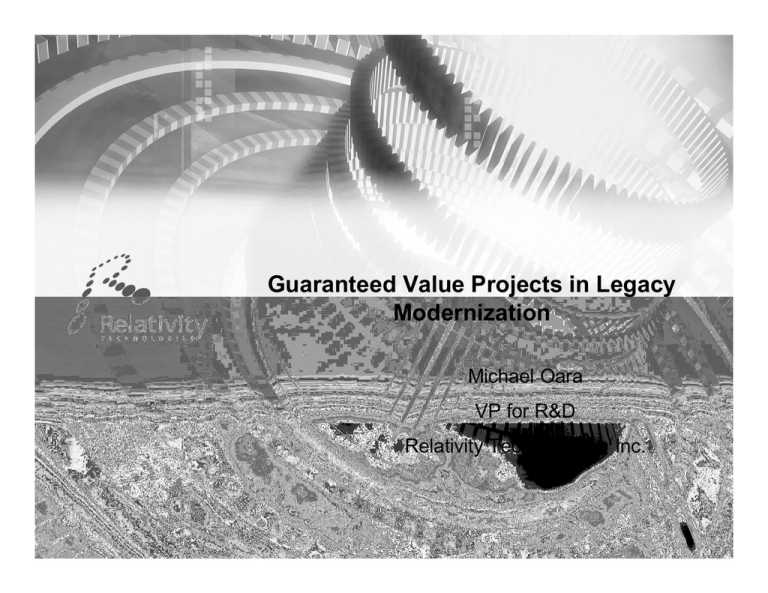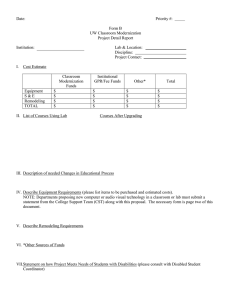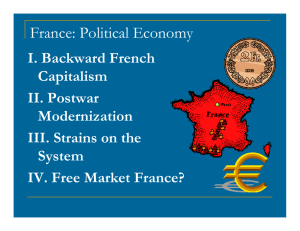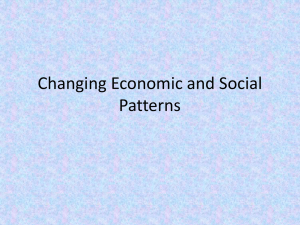Guaranteed Value Projects in Legacy Modernization Michael Oara VP for R&D
advertisement

Guaranteed Value Projects in Legacy Modernization Michael Oara VP for R&D Relativity Technologies, Inc. Business Problem Mainframe Applications – Key Attributes Millions of lines of code, poorly documented Typically 10 – 30+ years old Complex, brittle, difficult to enhance Maintained by antiquated tools Drive core business processes Issues with regulatory compliance Global 1000 IT Environment 60% of enterprise applications will remain on high-end mainframes through 2010 Source: Optimize Magazine Reality: Mainframes worldwide contain >200 billion lines of COBOL Code (IBM) Complexity: limited understanding of applications ? Outsourcing – increases transition time and costs ? Risk – increased Source: IBM ? Regulatory compliance – more difficult and costly 60-80% of IT budgets go to maintaining existing systems* ? Time consuming to make changes ? Risk of destabilizing system ? Difficult to train new team members Complexity reduces flexibility and increases costs Causes of complexity Enterprise Application Portfolio Causes: Cumulative effect of years of changes Inadequate documentation Technical complexities stem from: ? Inadequate tools ? Non-standard code ? Large and complex programs Modernization Projects ? Modernization projects are Costly ? Time consuming ? Risky ? ? Companies hesitate to make large investments for risky projects ? Cost overruns may lead to project cancellation Solution Create a modernization path with incremental steps Insure that every phase … ? delivers clear value ? serves as its own justification, independent of the next steps Four major types of modernization projects… ? Documentation ? Clean-up ? Restructuring ? Migration ROI for Modernization Projects Activity Analysis Detailed design Coding Unit testing System testing Deployment Documentation % Time consumed 15% % Effect of automation 30% 10% 15% 20% 25% 10% 5% 30% 5% 15% 5% 5% 75% Legacy Documentation Application statistics Code defects Application structure Business rules Documentation: Application statistics Statistics Volume measurements ? By LOC ? By cyclomatic complexity Volume reports ? By application, module ? By supporting technology Benefits Measure team productivity Measure quality Estimate change costs Remove obsolete technology By access to data ? Interfaces ? Databases Determine interdependencies Determine costs of modernizing database Application Analyzer: Cyclomatic Complexity Report Documentation: Application structure Documents Benefits Help to determine: Call maps Data access Data flows Online flows Application interfaces Program change impact Data change impact Batch outage consequences Use case scenarios Testing scenarios Side effects of application replacement Application Profiler: Call Map Diagrammer Application Analyzer: Global Data Flow Analysis Application Profiler: Reference Reports Application Analyzer: Batch Application Viewer Documentation: Code defects Code defect: A departure from internal standards and best architecture and code practices – not to be confused with “bugs” Code defects result in… ? Frequent outages ? High maintenance costs ? Difficulties in applying enhancements and changes Documentation: Business Rules (1) Definition A statement expressing a policy or condition that governs business actions and establishes data integrity guidelines. A business rule statement must always be true. Caution: A correct definition is needed for the purposes of any project using business rules Not to be confused with flow, process or implementation Business rules are usually hidden deep in the code, hence the need to discover them Application Profiler: Business Rules Business Rule Manager: Business Rule Management Documentation: Business Rules (2) Classification (many classifications are possible) ? Validation (constraints on inputs) ? Computation (of outputs) ? Triggers Automatic detection is possible to a certain degree (30% - 95%) Business Rule Manager: Business Rule Discovery Documentation: Business Rules (3) Attributes: Business description Classification (validation, trigger,…) Functional area (customer, product, …) Pointer to implementation code Inputs and outputs Status (valid, approved, obsolete, …) Documentation: Business Rules (4) Documenting the application Change management ? User or Business Analyst has partial access Gap analysis Specification for application migration to a new technology implementation Business Rule Manager: Open for the business community Code cleanup and restructuring Cleanup: ? Source elimination ? Dead code elimination ? Superfluous code elimination ? Obsolete code elimination Restructuring: ? Modularization ? Application partitioning Code cleanup: Source elimination Eliminate: Unrefered programs Orphans Obsolete reports Methodology: Review user requirements Create cross-references Eliminate unrefered objects in multiple iterations Code cleanup: Dead code elimination Dead code: Program code, in an otherwise functional program, which can never be reached because of logical conditions. Why dead code? ? Programmer mistakes ? Application maintenance ? Package customization ? Debugging Troubles: ? Complicates maintenance ? Distorts program measurements Can be automated Typically we find between 3% and 6% dead code in old legacy applications Code cleanup: Superfluous code elimination Superfluous code: Program code, in an otherwise functional program, which does not produce any results in program output. Why superfluous code? ? Incomplete maintenance ? Reduction in program output Can be automated Code cleanup: Obsolete code elimination Dead code: Program code, in an otherwise functional program, which can never be reached because of nature of data. Why obsolete code? ? Business conditions change ? Technology change (response conditions) Can be automated Modularization Definition: Break large programs into smaller programs, which together deliver the same functionality Benefits: ? Increase code reuse ? Prepare for user interface change ? Web enablement Can be automated Application partitioning Definition: Break a large application into sub-applications which together deliver the same It is mainly for management purposes Applications: ? Establish migration or change progression ? Distribute the application between teams Migration: Data Most common projects: non-RDBMS to RDBMS migration Caveats: ? Clean up data before migration ? Do not allow radical changes in data structures ? Document data (example: what does FILLER1 mean?) Migration: Interface Most common: Web enablement Simple solution: screen scrapping Advanced solution… ? Break programs into reusable components ? Reconstruct the user interface ? Build communication infrastructure ? Reassemble mainframe components into callable programs Migration: Code Basic solution ? Completely manual conversion (documentation is useful!!!) ? Business rules based ? Partial automation (extract smaller components which may be automatically translated) ? Massive automation – works only in special cases. The Modernization Workbench™ The Modernization Workbench™ drives down the cost and accelerates the modernization, management, and maintenance of business-critical enterprise applications Step 1 ? Application source code is added into the Step 2 Step 3 Modernization Workbench™ ? The source code is parsed at a deep level ? An application knowledgebase is created showing all programmatic interrelationships Step 4 ? Visually-rich HTML-based documentation, flow Step 5 Step 6 charts and diagrams are generated ? Previously hidden information about the application, like “dead code”, is revealed ? The knowledgebase is refreshed to keep all documentation and information current for use with the modernization suite Modernization Workbench™ The Modernization Workbench™ drives down the cost and accelerates the modernization, management, and maintenance of business-critical enterprise applications Application Knowledgebase and Repository Multi Environment Repository Multiple environments can be simultaneously accessed by users 3rd party parsers are efficiently integrated ? Assembler ? OpenROAD ? RPG ? Others Modernization Workbench: Enterprise Architecture Source Code Mainframe Application Server RDBMS Deep coverage of the numerous enterprise environments Residing off the mainframe minimizes security, cost, and risk issues Individual users can execute tasks based on the latest source code Remote users (e.g. other offices, or outsourcers) can access current information via the Web Users focused on specific projects may operate in an ‘occasionally connected’ environment Modernization Workbench Modules Usage Developer Module Application Analyzer Application Profiler Business Rule Manager Application Architect Transformation Assistant Key Limited or no likely use Partial use likely Heavy use likely Systems Analyst Business Analyst Support QA Manager Application Analyzer™: Features and Benefits Application Portfolio Management and Assessments ? ? ? ? Visual, Interactive documentation and deep insight ? Team-centric and customizable ? ? ? ? Inventory reports give a total snapshot of your portfolio Complexity analysis and estimation allow managers to understand where to direct resources Impact analysis identifies the effect of changes Powerful querying tools deliver deep insight Multiple, interactive views illustrate programmatic and information flows Users always have access to the most current information about your application portfolio Reports and diagrams can easily be shared Application visualization is highly customizable Analysis tools can be tailored to suit requirements Application Analyzer: Call Map Diagrammer Application Profiler™: Features and Benefits Accessibility and usability ? ? ? ? Efficient application portfolio assessments ? ? ? Streamlined application management ? ? ? ? Information bottlenecks are removed No additional software simplifies management Intuitive interface accelerates user productivity Dynamic access delivers up-to-date information System documentation is easy to retrieve Powerful diagrams illustrate inter- and intraprogram relationships Interactive and synchronized views allow for efficient portfolio assessments Analysts can audit and control business logic Managers gain a complete overview of their systems Complexity analysis helps to focus resources Impact analysis allows analysts to control the effect of changes to applications Application Profiler: Screen Shots Complexity report Reference reports Business rule management Call map diagrammer Business Rule Manager™: Features and Benefits Accelerated business rule identification ? ? ? Powerful business rule management ? ? ? ? Integrated approach magnifies benefits ? ? ? Sophisticated tools help to quickly identify rules Powerful interrogation simplify manual searches Creation of rules directly from a search screen accelerates the collection process Persistence ensures that rules are not lost as programs change Rules Filter helps to focus business rule searches Analysts can categorize and describe their portfolio of business rules, simplifying ongoing usage Customizable interface allows analysts to efficiently manage their business rules portfolio Browser-based access allows users to remotely search, audit, and modify the latest business logic Rich diagramming and search functions help users to focus searches Convenient reports help analysts to plan, manage, and share business rules Business Rule Manager: Screen Shots Business rule discovery Business rule management Integration with Application Profiler Application Architect™: Features and Benefits More efficient operations through componentization ? ? ? Reduced complexity with application renovation ? ? ? Extend applications through Web Services ? ? Multiple componentization tools enable the creation of more reusable and maintainable programs Examines all dependencies to ensure that the extraction is a functionally complete component Coverage Report identifies additional opportunities and ensures completeness Reduces complexity by partitioning business logic, data access, and user interfaces Ensures compliance with corporate standards by propagating naming conventions Eliminates dead, redundant, and duplicate code to reduce complexity and enhance maintainability Accelerates the web-enablement of components within your applications Enables external monitoring of processes Application Architect: Screen Shots Refactoring of application to increase maintainability Transformation Assistant™: Features and Benefits Component-based modernization ? Modernization to a fully functional application ? ? ? ? Modernization Workbench integration speeds your initiative ? ? Migrate selected components to take advantage of the Java environment Tight integration with Application Architect speeds modernization projects Highly assisted path to modernization reduces costs and risks associated with the migration Create database schemas to accelerate the migration Generate Internet accessible screens that transition from your enterprise applications Management of business logic ensures functional equivalency of modernized application Reports illustrate programmatic relationships, simplifying the transition to a new environment




